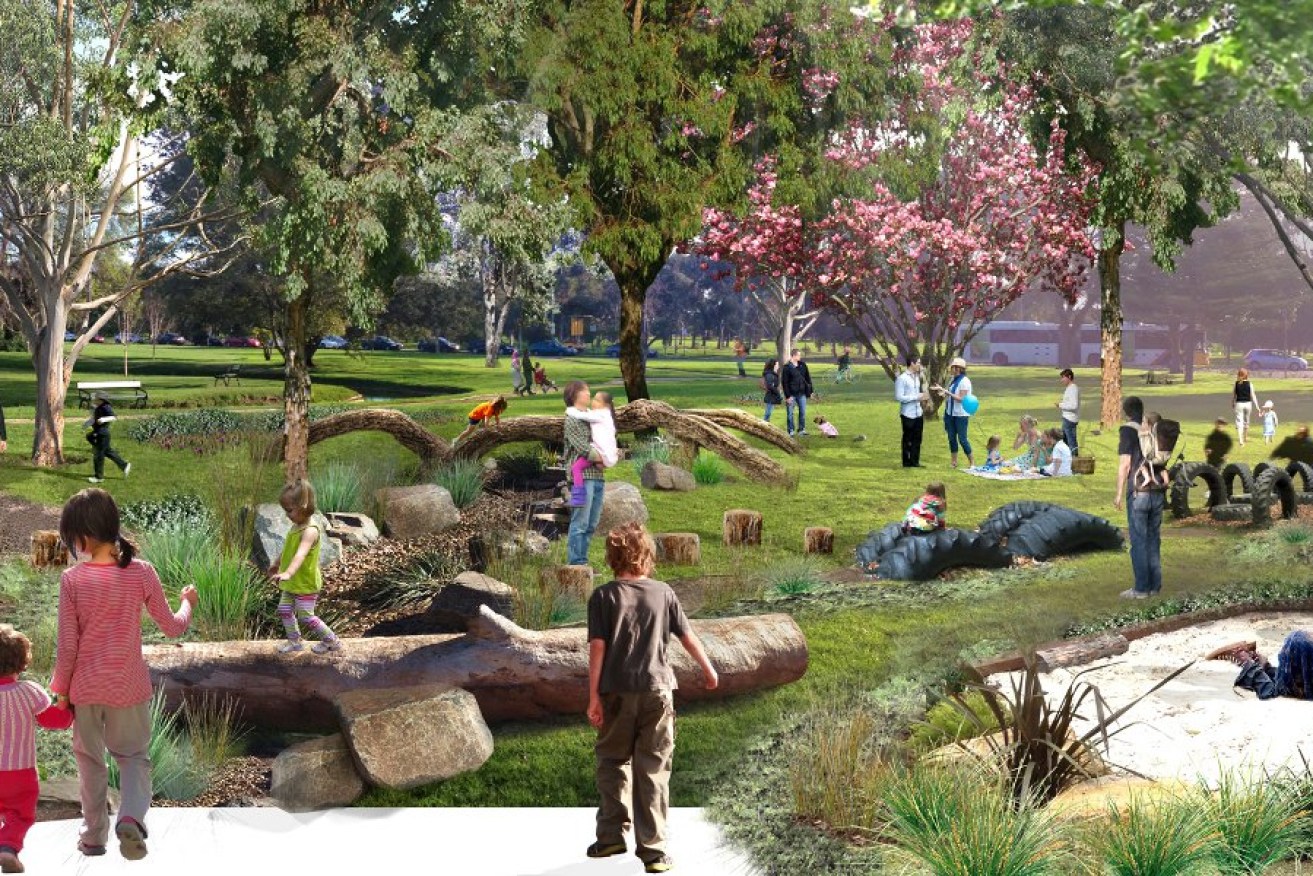Schoolyards stymie free play

A render of what a natural playground might look like. Artist: Alex Ricketts
It’s not just public playgrounds that risk alienating children – following Peter Semple’s recent article arguing the need for more “natural” play spaces in Adelaide, educator Paul Johnson suggests many school grounds could also benefit from a re-design.
The vast majority of existing modern playgrounds have been designed by adults to be permanent, to look child-friendly, to be tidy, and to placate feelings that children ought to be provided with special places.
Unfortunately, these design features have not addressed children’s need to construct, to imagine, to find places of refuge, or to just be with other children. Nor have modern playgrounds allowed for fascination that engages and extends children’s interests.
It’s not surprisingly, then, that children come to feel alienated by these monuments to misunderstanding, with growing numbers engaging in unsafe or anti-social behaviours. Unwittingly, teachers and carers have probably compounded the situation by managing misbehaviour without wondering if the playground might be the problem.
This may be because, since modern playgrounds introduced play structures and equipment 150 years ago, many educators have come to accept as normal the mismatch between formally designed playgrounds and places where children actually prefer to play. They have inherited a mindset sees school grounds designed to meet the ideals of adults, rather than children.
Plato advised that educators should “let your children’s lessons take the form of play”. Today, evidence demonstrating that play supports children’s social, emotional and cognitive development underlines Plato’s advice.
Playing provides children with opportunities to enjoy freedom and to exercise choice over their actions, as well as for testing boundaries and exploring risk. It offers a wide range of physical, social and intellectual experiences. It also fosters independence and self-esteem; develops respect for others; offers opportunities for social interaction; supports well-being, healthy growth and development; increases knowledge and understanding, and promotes creativity and capacity to learn.
Although play is recognised as a significant contributor to education processes, researchers have warned that recent trends threaten children’s right to play. In response, advocates have rightly emphasised play’s benefits and its essential contribution to learning and wellbeing. However, while the educative importance of children’s play is clear, there is a risk that if children experience only guided forms of play, the full value of free play may be diminished.
Most early childhood educators understand the importance of play and remember that it has many forms. Most educators also accept that freedom is a basic tenet of play, but fewer are likely to have considered a fundamental contradiction in educator assumptions about schoolyard play. In particular, educators are unlikely to have reconciled beliefs that children’s play ought to be freely chosen and self-directed, with using play as a pedagogical tool. Similarly, many educators will not have considered children’s recess and lunchtime play as a pedagogical issue, let alone thought about the hidden curriculum of school grounds.
A solution to this dilemma seems to be in educators remembering that for children, play is not about products or outcomes, it is about the act of playing. Play is usually fun but often it is far from simple. In free play, children naturally negotiate new meanings for objects and people: sticks, for example, are transformed into horses, wands or spoons; possessions are transformed into symbols; and humans are transformed into superhuman.
Unfortunately, children’s play is too often subjected to other’s ends and we begin to understand what American educator reformer John Dewey meant when he wrote that “the source of whatever is dead, mechanical, and formal in schools is found precisely in the subordination of the life and experience of the child to the curriculum”.
Liberating schoolyard play and realising its educative potential has proven difficult because mainstream education has focussed on play as a means to deliver predetermined goals and because modern playgrounds prioritised gross motor movement and competition. Change is possible, however, and just a little more than decade ago some European, North American and Australian communities began greening playgrounds precisely because children valued them.
The greening impetus was supported by evidence that playing in green school grounds was linked to stronger academic performance in maths, spelling, reading and writing, and by confidence that green nature reduces stress, restores attention and improves health outcomes. All these benefits were and are scientifically verifiable.
First and foremost, playing with and in nature is fun, and when it is fun, what follows is a natural extension of free participation in rich and diverse contexts. My own research at Galilee Catholic School in Aldinga showed, for example, that playing freely in nature supported children’s creativity, feelings of belonging, and sense of efficacy.
In the 21st century, educators can embrace a new paradox of play – by supporting and elaborating children’s interest in playing freely with and in nature.
Educators may not be able to prescribe where children’s playful inquiries will lead, but surely after more than two millennia we can at last take Plato’s advice and provide the physical and cultural conditions which will truly let our children’s lessons take the form of play.
Paul Johnson is an educator and PhD student who consults in playground design, play culture and teacher professional learning. This article was first published in TOPICS, the Journal of Australian Catholic Primary Principals’ Association, and is republished here with the author’s permission.




